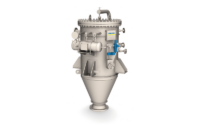Jet Pulse Filters
Filtration solutions for the treatment
of process liquids and gases.


Jet pulse filters are used for air & gas purification, dust collection and product separation in numerous applications at various industries. These include the chemical and pharmaceutical industries, petrochemicals, energy production, and waste recycling and processing. In this context, the use of jet pulse filters in the filtration of synthesis gas as part of waste gasification processes is particularly noteworthy. The form of cleaning used with these filters is jet-pulse cleaning, an intense blast of compressed air or intergas that abruptly cleans the individual filter cartridges or cartridge registers while the remaining filter cartridges stay in filtration mode. With differential pressuremonitoring and control, jet pulse filters operate continuously with automatic cleaning.
The dimensioning of FAUDI jet pulse filter systems is project-related and thus matched to your application, for example design, adapted dimensions and materials as well as customer specifications.
Jet pulse filters impress with an exceptional cleaning effect thanks to the individual blow-back capability of the filter elements. The electrical or pneumatic pulse timing ensures optimum adaptation to your processes and guarantees continuous operation with minimum filter differential pressure.
Thanks to their compact design, our jet pulse filters are even suitable for confined installation situations. The design of the filters and filter internals is also available for applications with high process temperatures, which makes them particularly versatile.
The robust design of our jet pulse filters ensures a long service life and reliable performance, even under challenging conditions. This means you benefit from a sustainable and efficient solution as well as a reliable spare parts service.
Request advice now and find your ideal solution!

FAUDI jet pulse filters are equipped with filter bags made of synthetic fibres. In hot gas filtration (up to 600 °C) or for resistance requirements, filter cartridges made of sintered metals or metallic wire cloth are being used. In filter operation, the filter bags are flown through at a very slow speed from the outside to the inside. The solid particles are retained on the surface of the filter medium, or rather of the filter cake deposited on it. The purified gas flows out of the filter bag or candles at the top. When a defined differential pressure is reached, the cleaning process will be initiated. With the aid of solenoid valves, intensive pressure surges with a cleaning gas (usually nitrogen) are selectively delivered from a receiver tank to the inside of the filter bags via registers and nozzles arranged above the filter bags. Due to the reversal of the flow direction (now from the inside to the outside) and the slight inflation of the filter bags, the filter cake lying on top is detached and the dust particles sediment into the lower collection space of the filter container. This cleaning process can be carried out without interrupting the filtration process, thus enabling a continuous production process.

